never knew that Jubalees were used on freight. great photos
thanks!
never knew that Jubalees were used on freight. great photos
thanks!
Miningman, love the way that G3 is cracking the whip on Sunday morning! What a classic looking train!

Don’t forget the Grand Trunk! [:D]
I thought the Grand Trunk hauled circus elephants?
Just kidding! GREAT job on that watercolor Becky! You should take commissions!
Awesome water color! It would be great to see that unit rolling again someday too!
Canadian Class 5 - Canadian Pacific Pacifics
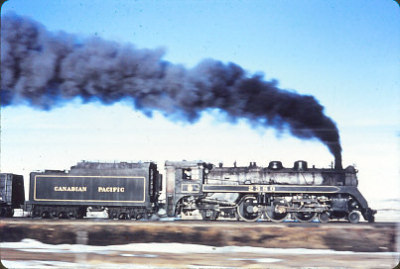

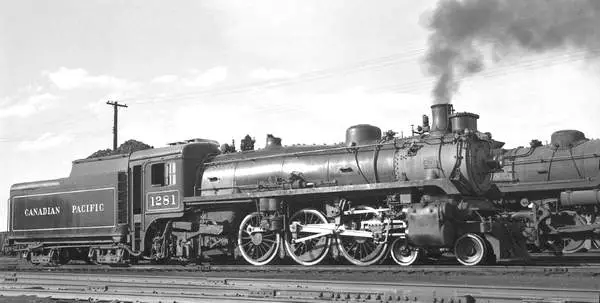

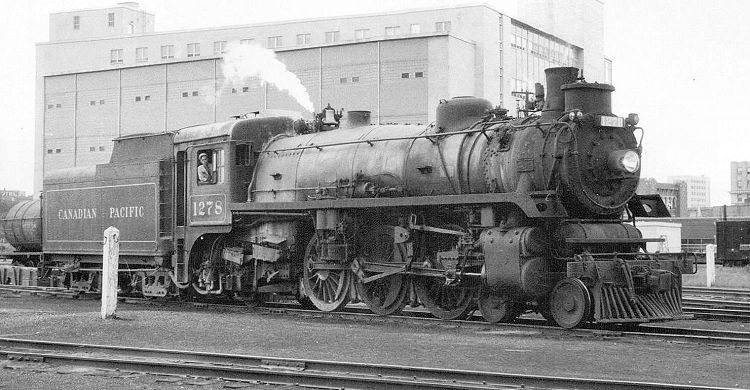
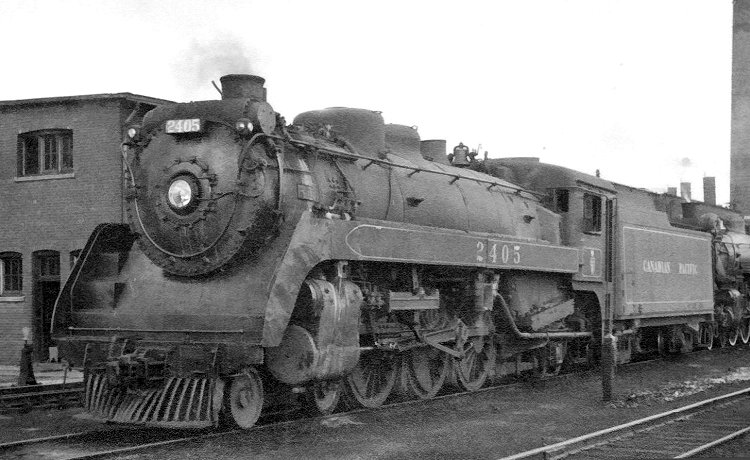

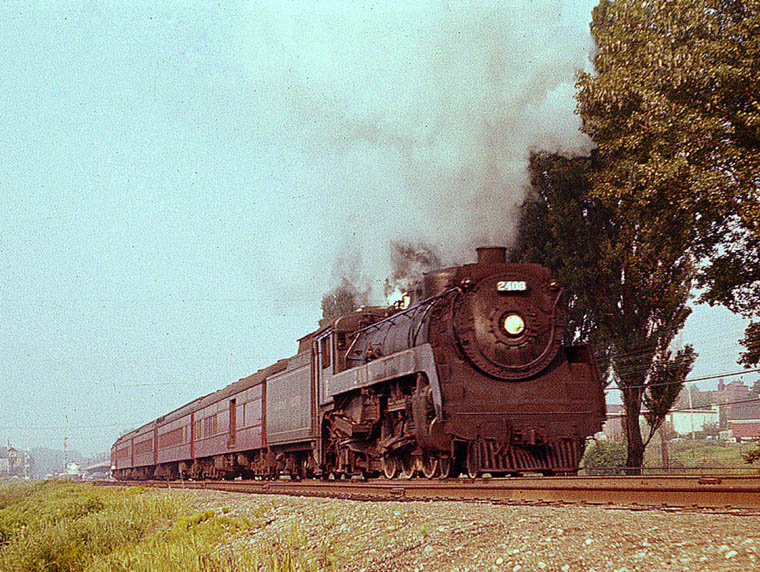

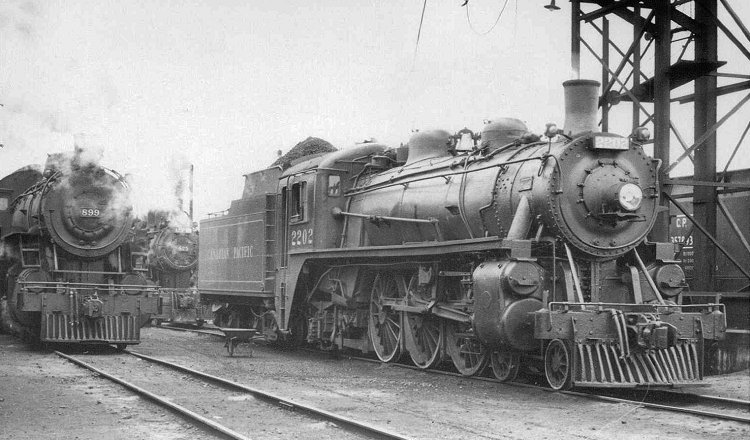
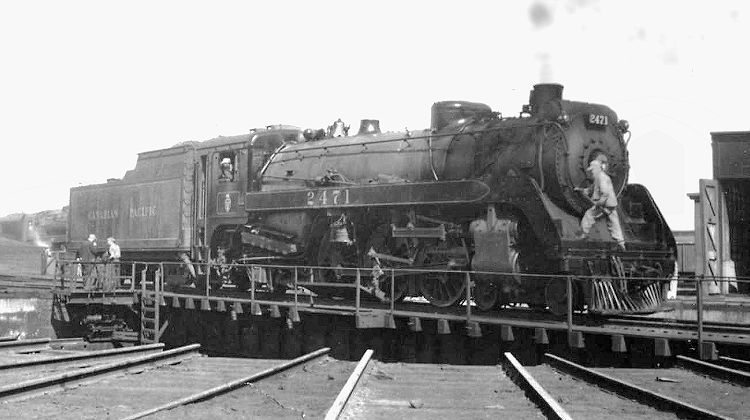
Maybe some of you know about this, but for those who don’t…
David P. Morgan did a book in 1961, published by Kalmbach, called simply “Canadian Steam!”, the exclaimation point being his.
It’s a photo anthology of Canadian steam locomotives, just like kgb’s favored us with. Great rail photographer names like David Plowden, J.P. Lamb, Don Wood, Phil Hastings, Jim Shaughnessy, A.C. Kalmbach himself, and John A. Rehor among others.
Mine’s a second printing from 1964, don’t remember just where I found it but I’m sure glad I did. All black-and-white shots but all good or better than good.
It’s one to keep an eye out for, trust me. Check those train shows and used book dealers!
Added more to the Canadian Pacific Pacifics - they had a lot of them - sleek varnish runners and brawny dual purpose units.
Also added a few more to the Canadian Pacific Jubiiees and Hudsons.
daveklepper, the caption on this photo said this Jubilee was heading west to Smith’s Falls with 60 cars of freight…
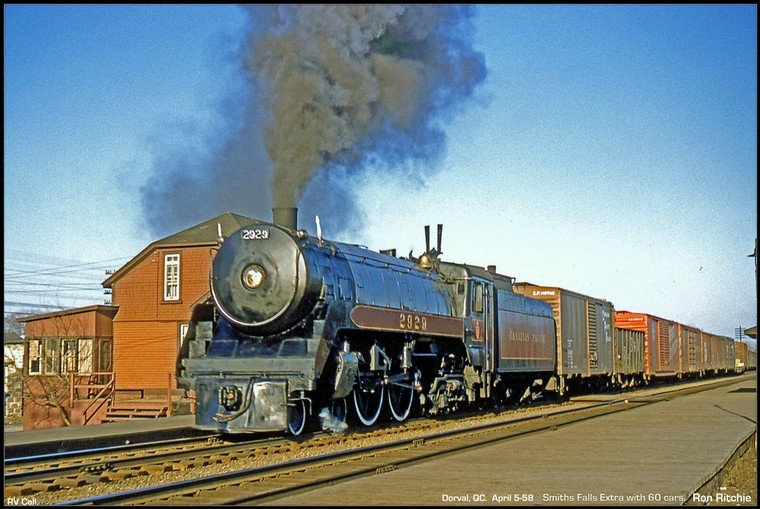
Thank You.
This information indicates that at least the F-2-a class with 80 inch drivers had mechanical stokers, but is unclear if the F-1-a class with 75 inch drivers was also so equipped.
http://steamlocomotive.com/locobase.php?country=Canada&wheel=4-4-4&page=cpr
Definitely agree if not equipped the fireman would indeed be shoveling like mad.
This use of the Jubilees on relatively long freights on the flatter districts is reminiscent of the Southern Pacific 2-6-0 Moguls in the Central Valley of California. They earned the nickname “Valley Malley” for their ability to pull long strings of freight on the relatively level terrain.
Canadian Pacific used its Hudsons and Pacifics (and Jubiliees) as dual purpose locomotives probably more than most other railroads…they were prodigious freight haulers as exemplified by H1b Hudson 2811 leaving Smith’s Falls with what looks like about half the yard tied on to the tank…
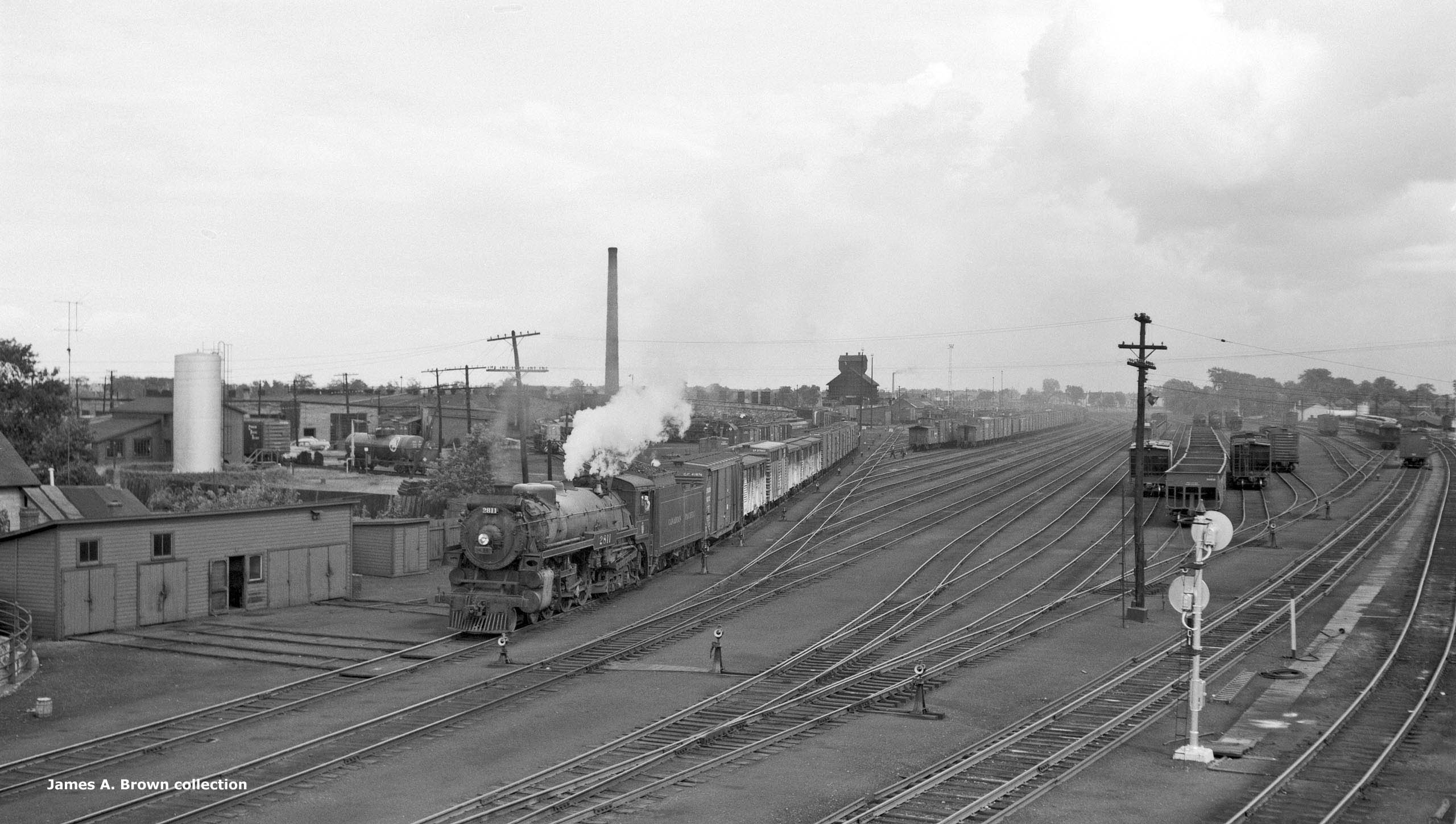
This answers a few questions.
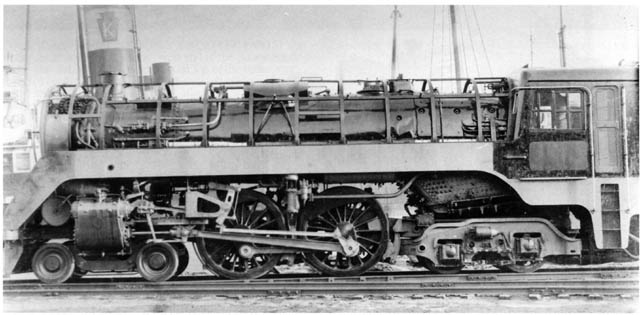
This revealing photograph shows a CPR Jubilee 4-4-4 type with its semi-streamlining removed.
CLC/Marine Museum of the Great Lakes at Kingston.
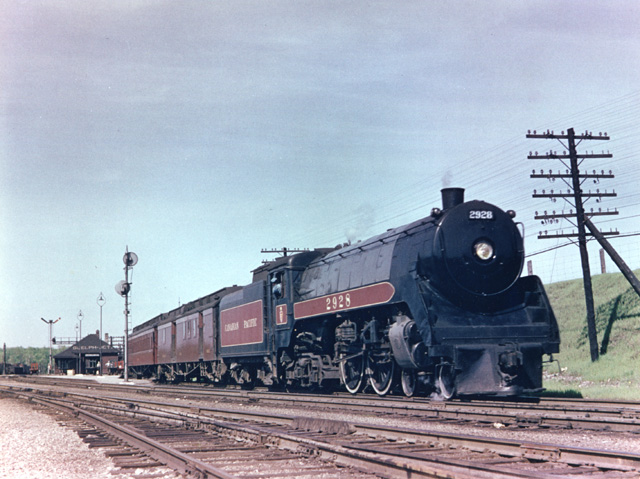
A modern steam locomotive hauling two ancient wooden passenger cars on a branchline train.
CPR Jubilee 2928 ( #1942 3/38) backs train #637 from Hamilton into Guelph Junction, May 24, 1954.
It will wait for a meet with Montreal-Chicago #21 Chicago Express before continuing on to Goderich.
J.F.Beveridge/Collection of F.D.Shaw
CPR 2910-2929 Cyl. 16 ½ x 28 Drv. 75" pressure 300 pounds and only 25,900 t.e. weigh only 212 ½ tons in working order and are hand-fired. This single order of 20 small, lightweight locomotives were unique to the CPR where they were used on local passenger and branchline freight trains. #1924-1943 11/37 to 3/38
These twenty modern, semi-streamlined 4-4-4 Jubilee type engines were hand-fired due to their small size. Designed for light passenger trains and branchline freights they were unique to say the least. No other Canadian and few American railways used this wheel arrangement.
It was the earlier 3000-3004 with 80" drivers and stokers built 8/36 by MLW that became famous for their recor
So the mystery is solved …the original locomotives #3000-3304 80" drivers had stokers. The later built order of 20 engines with 75" drivers #2010-2929 were hand fired.
In the above picture of #2928 at Guelph Junction, this is the locomotive preserved at Delson, Quebec and it’s sibling #2929 is at Steamtown, USA. None of the beautiful and fleet of foot 80" drivered 3000-3004 were preserved. One was supposed to be saved but a “communication mixup” sent them all to scrap. We heard that one before, several times.(B&O, NYC, a Hudson no less, several others…what a load of hooey)
Regarding the picture at Guelph Junction well wouldn’t it be nice to detrain from the Chicago Express for the short hop to Hamilton to the art deco TH&B station. There was a kosher deli there that made one mean corned beef sandwich I tell ya. With all the crazy quotations and philosophy of the day, framed sayings on the walls. Riding behind a Jubilee in an ancient wooden coach, and an ancient wooden baggage car just ahead of you.
Open the window, the locomotive is right there! Coal smoke and cinders abound. Wonder if the people knew this was all heading to extinction very soon. I think they did but perhaps did not realize the extent of all of it.
The Chicago Express was a real moneymaker for Canadian Pacific …that train #21 Montreal-Chicago was always packed full. It was very popular. Lots of business people and head end business. When CPR quit in the early 60’s with the train there was quite an outcry. Essentially they gave the business to the CNR.
I lived in this area in 1954. Was not worried about steam or passenger trains yet, a little bit, but definitely remember getting that “this is too good too last” feeling around 1957 and full blown realization of tragic loss in 1959.
Would it be all that bad if it all came back tomorrow? Not at all. Not so bad.
Miningman, that picture you posted of the train along Lake Shore Boulevard is about a fifteen minute walk from where I live on Roncesvalles avenue which would be located above near the 7th coach of the train. The big building in the background is St. Joseph’s Hospital and the house with the cone-shaped roof still stands. There used to be a station at the bridge that you can see in the background(which carried streetcars over the road and tracks) but all that is left of the station are concrete stairs that go nowhere. A funny thing about the car in the picture, it looks fairly modern for the time the photo was taken which I would think was the early 1950s. I’d almost think it was a Mini, but they only were introduced in 1959. So, when was that photo taken?
54light15- November 1959!..so it could be a mini. Loco #2857 Train 324 Sunday only, it’s Sunday morning at 9:04am. 2857 is nearing the end of it’s days.
The sleepers carried originated in New York City, Boston, Pittsburgh and Cleveland.
Here is a pic of Train 324 in June 1968, with a single FA #4095 but still carrying heavyweights!
The sleepers were heavily patronized. The sleeper service ended Oct. 1970 and was replaced by CPR RDC’s, usually 2, a RDC-4 and a RDC-2. It became daytime train only and terminated in Buffalo.
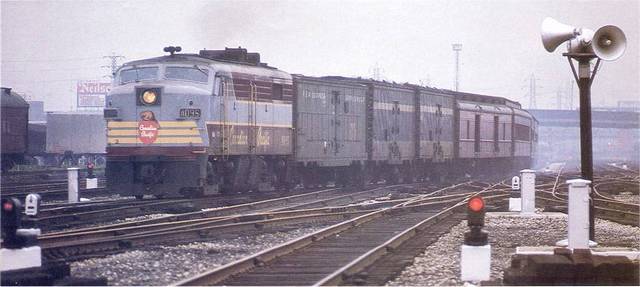
Part II
Here we are August 1963. The New York Central, Canadian Pacific and TH&B had a % arraignment for locomotive power for the train. Just left the TH&B station in Hamilton heading to Buffalo.
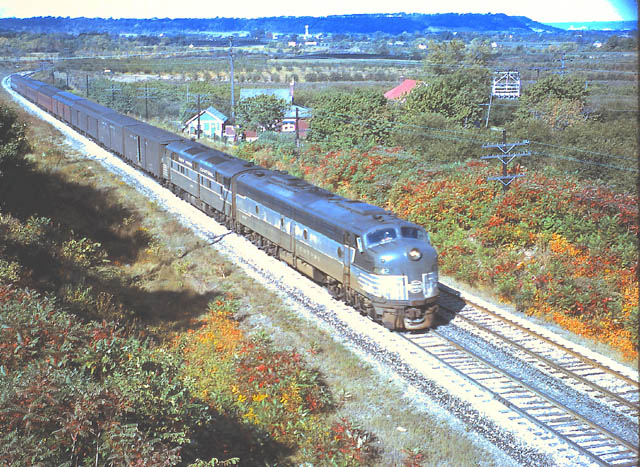
Part III
Here is what became of the well patronized and mighty overnight train to New York City with sleepers for Boston, Pittsburgh and Cleveland.
The forces of darkness have prevailed and we have been sold a bill of goods. Witness progress in action as civilization has turned it’s back on history, reasonable overnight service, convenience, heritage and there goes our trains.
I rode this RDC very near the end of service, it was not yet a VIA train, which did not last long, out of Hamilton and back just to say I did it and ride/see the TH&B rail’s to Buffalo before the already announced VIA takeover.
Buffalo’s New York Central’s Terminal was in serious decline and a mess. Bought a pack of Marlboro’s and then back home to Burlington.
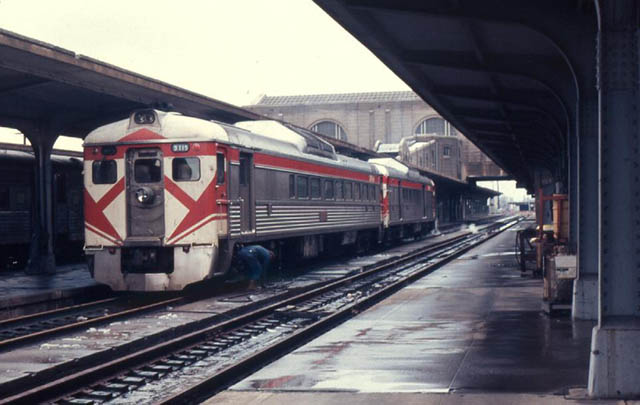
At least the Hamilton TH & B station is still in use for passenger service. Forces of darkness indeed.
54light15,
Nice to see the photo of the Hamilton TH&B station and know a bit of the old New York Central survives and is likely well cared for in Canada.
Canada and America do have a much more common heritage in railroading than most Americans realize. Some of this is because our neighbor to the north is a very very silent one. Canada in many respects has retained much of its British heritage - hence the queens picture on the money and crown on the automoblile license plates.
For you Americans feeilng so independent - the English often consider us one of their more independent colonies along with Canada and Australia and other lost colonies such as Egypt, India and South Africa. In both the First and Second World War the English Army prefered Americans to fight as one of their colonial army divisions. Which was quite a challenge for General Purshing and General Eisenhower to overcome.
Similarly, the British have left their fine railroad heritage in Egypt with wonderful track and signal work all the way down the Nile River and also have left this in India. I would venture to say that British railfans today would consider the American railroads as one of their rougher if not uncouth technological offspring. And likely rightly so.
Canadian Railroads however have tended to copy the American designs in track structure and locomotive and rolling stock design - hence the Janey couplers, four wheel car trucks, passenger cars with vestibule ends, and spiked rails.
Canada has been traveled by the famous New York Central subsidiary TH&B but America has been better traveled by the Canadians with the Central Vermont Railroad and the Grand Trunk Western. Which brings us to the city of Detroit.
Now Detroit for much of its life one of the largest and most powerful manufacturing cities in America is for the most part situated on the northern border of the states